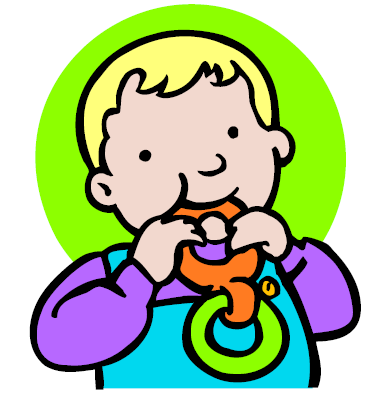What to Do and Say
- In a calm, serious, and firm voice say to the biter, “Biting hurts. You can bite an apple or a carrot, but I can’t let you bite Jimmy.” Often children do not realize that biting is painful.
- Help the child that has been bitten. You could say, “I think that hurts. Let’s wash it with a cool wet towel.”
- Involve the biter in helping to make things better. Help the biter understand the consequences of her actions and the seriousness of the action.
- Encourage, but do not force the biter to comfort the victim with kind, gentle words or touch. Respect the wishes of the child that was bitten.
- Teach biters new skills. Teach them simple words to help them feel safe, such as “my turn” or “stop.” Read a children’s book about biting such as “Teeth are Not for Biting” by Elizabeth Verdick.
- Involve both children in a calming activity, such as play dough, sand or water play, to help them relax.

Think about what happnd
Analyze the situation. Who, What, When, Where, and Why?
- Who was involved in the situation?
- What were the children doing just before the incident?
- When did it happen (time/activity)?
- Where did it happen?
- Why do you think it happened?
Was the child hungry or tired?
Is the child experiencing teething pain?
Are there enough favorite toys?
How can you help?
Biting
- Biting is a common behavior in children ages 14 to 24 months. Most biting occurs in toddlers who have limited language skills. As a child’s language improves, biting usually stops.
- Biting has many causes. Biting can be caused by teething pain, hunger, anger, frustration, stress or boredom.
- Biting may occur when a child is trying to protect his space or trying to prevent another child from taking his toy.
- Biting may signify that a child is going through a difficult transition such as giving up her bottle, moving to a big bed or welcoming a new baby to the family.
- Biting occurs more often when a child is confined in a small space and feels like his space has been invaded.
- Biting is a sign a child needs extra help. When you stay close to a child, it can help her feel safer and she will be less likely to bite. Give the child hugs and attention.
- A child that bites needs to learn new coping skills. Stay calm and teach the child a better way to respond using words.
| Causes of Biting |
Ideas to Try |
| Teething pain |
Offer child crunchy snacks.
Offer child cold water, frozen juice bars or teething rings that have been chilled in the refrigerator. |
| Hungry or thirsty |
Keep water available for children that need a drink.
Add additional snack times (most young children should not go more than two hours without food or water). |
| Need more adult attention |
Stay close to child. Give child additional attention and hugs. |
| Unable to express needs |
Help the child learn to use words to express needs. “Water please.” “I want truck..” |
| Child is still putting everything in mouth |
Offer crunchy and chewy snacks, like pretzels, crackers and apples. Show children toys on which they can chew. |
Frustration or anger
(I.E. Activity too hard for child) |
Give child choice of activities. Provide calming activities such as play dough, sand or water play.
Put the child’s feelings into words. “Billy, you are angry because ….” |
Feels threatened
(I.E. Someone trying to take his toy) |
Have more than one of favorite toys. Teach child to use simple words like “mine,” “stop,” or “my turn.”
Child needs to learn words are more powerful than biting. |
Trying to communicate/doesn’t
Understand that biting hurts |
Teach positive ways to show affection such as gentle hugs and kisses. Tell the child “Biting hurts.”
Comfort the victim first. Involve the biter in helping the victim. |
Feels overwhelmed
(I.E. Change of activity, clean-up time, move to new space)
Too much noise or light
Too many people |
Reduce the number of transitions or make transitions calmer. Lower the lights, use songs, give a 5 minute warning.
Create private spaces for children to relax and recharge. Rethink your schedule. Can things be simplified? |
Stressful changes
(I.E. New baby, new caregiver, move, divorce,
Giving up bottle or crib) |
Talk to the child about the changes in her life. Change is hard.
“You miss ....” Help her learn to talk about her feelings instead of expressing them through biting. |
| Confined to a small space with group of other children |
Toddlers need space. Move furniture to reduce crowding. Play outdoors.
Set up activity areas and keep toys within easy reach. |
| Bored |
Give children choices. Do not expect toddlers to sit for very long.
Toddlers do better in small vs. large groups. |
| Receives a strong reaction (attention) |
Help child learn positive ways to receive someone's attention. |
| Aggression (I.E. Wants the toy another child has) |
Provide close supervision of the biter. Be ready to step in to protect other children. |
Resource: Children’s Book
Verdick, E. (2003). Teeth are Not for Biting, Minneapolis, MN. Free Spirit Publishing, Inc.
Sources
Penn State Better Kid Care, Biting and Sharing. PennState.
Contra Costa Child Care Council Tip Sheets. Why do Children Bite? CocoKids.
University of Missouri-Columbia, ParentLink, What To Do About Biting? MU.
Byington, T.
2006,
Giving R Best 2 Kids: Development & Behavior - Biting,
Extension | University of Nevada, Reno, FS-06-81


